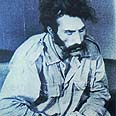
Glimpse into Egyptian captivity
New exhibit showcases rare photographs of beaten, injured IDF soldiers taken captive during Yom Kippur war. 'Life story of disabled veterans has been interlaced in first 62 years of State of Israel," says Disabled IDF Veterans organization chair
Thirty-seven years have past since Israel was surprised by the Egyptian and Syrian armies, who fired the opening shot of the Yom Kippur War.
Two hundred and ninety-four IDF soldiers were taken captive during the harsh battles, mostly on the Egyptian front, and were released only two months after the war began.
During those eight weeks, the captive soldiers suffered horrid humiliations, exhausting interrogations and brutal beatings.
A first-of-its-kind exhibition at Beit Halochem in Jerusalem gives visitors a rare glimpse into the events of those weeks, from the point of view of the POWs.
The exhibit, which opened Thursday, showcases documents, different items taken from captivity, and rare photographs revealed to the public for the first time.
One of the photographs is of Baruch Shemesh, who was documented in captivity by a foreign reporter.
During the war, Shemesh served as a reservist at the Lituf strongpoint in the Sinai Peninsula.
Shemesh was captured on the second day of the war, while his pregnant wife and four children eagerly awaited for his return.
"The photographer spoke Persian. He asked to take our photo and literally chased us," Shemesh recalled.
"I completely forgot about it, but when I returned home I saw the photo and my wife told me the photographer passed it to her through the Ministry of Defense a week before I was released. Up until then she didn't even know whether I was alive or dead," he said.
IDF soldiers taken captive in Sinai (Photo: Merav Binyamin)
Even though Shemesh has a large oil painting of the photograph hung in his living room, he still gets emotional knowing the picture of him beaten up and despaired is being displayed in public.
"It is somewhat stressful, because it takes me back to a difficult period of captivity and torture. Because I had red paratrooper shoes and a mustache, the Egyptians were convinced that I was a commander, and subjected me to particularly harsh torture. In the photo you can only see my swollen hands, but the mess all over my body is hidden underneath my clothes," Shemesh noted.
Capturing moment of despair
Another display in the exhibition is a prayer formulary that Natan Margalit carried back with him from Egyptian captivity.
During the war, Margalit was completing his regular army service at the Orcal post in northern Suez Canal, and was captured after a prolonged battle against the Third Field Army which laid siege to the Bar-Lev line in Sinai.
Margalit and his friends were held in the Egyptian prison for two months, before being released as part of a prisoner exchange deal between the two armies.
"One day the wardens took us to the Cairo Synagogue in order to publicly display us – the Israeli prisoners – to the Arab media. We prayed with members of the Jewish community, and later I requested to take the formulary with me," recalled Margalit.
The community members granted his request, and the prayer book is displayed in the exhibit, along with Margalit's photo, taken at the Egyptian capital's synagogue.
Another display features souvenirs brought back from captivity by Uri Aharenfeld, who served in the Nahal Mutznakh (Airborne Nahal) battalion.
Two days before the battles started, Aharenfeld arrived at the Mezach Post in the Suez Canal, and was taken captive by the Third Field Army after 180 hours of battle.
Prior to his captivity, Aharenfeld was injured three times from shrapnel, but insisted to continue fighting – until then Defense Minister Moshe Dayan ordered the position commanders to surrender.
Shortly after, Egyptian soldiers arrived at the post and took Aharnfeld and his comrades captive.
A picture capturing the moment of despair, in which Aharenfeld is removing the Israeli flag from the flagstaff, is also displayed in the exhibition, alongside other photos in which Aharenfeld is seen carrying an injured soldier after being taken captive.
In addition to the photos, the exhibit also showcases Aharenfeld's uniform and a pair of handcuffs that he wore in the Egyptian prison.
The exhibition was initiated bythe Zahal Disabled Veterans Organization and Awake at Night Foundation, which helps soldiers who had been held in captivity.
"The life story of the IDF's disabled veterans has been interlaced throughout the first 62 years of the State of Israel," said Chairman of the Disabled IDF Veterans organization Haim Bar.
"We are acting to impart the legacy to the State's younger generations by exposing them to these heroic stories," he said.
- Follow Ynetnews on Facebook











